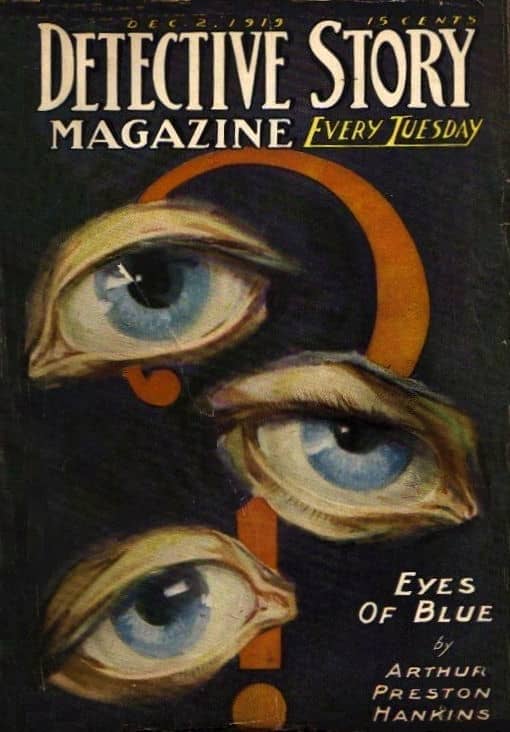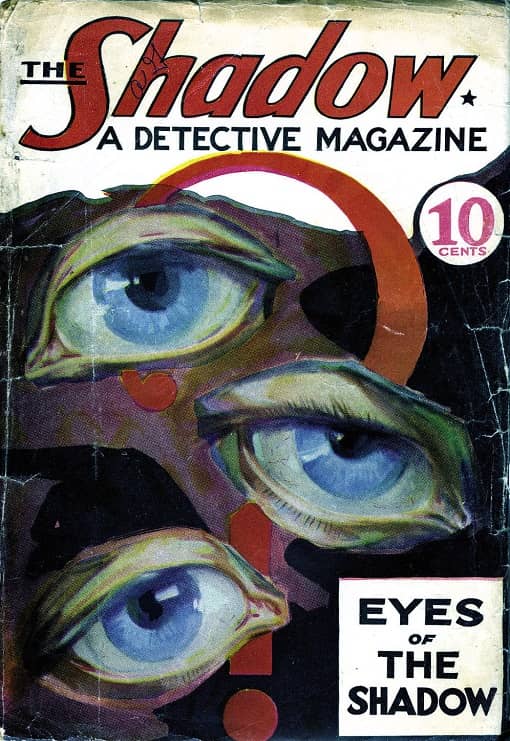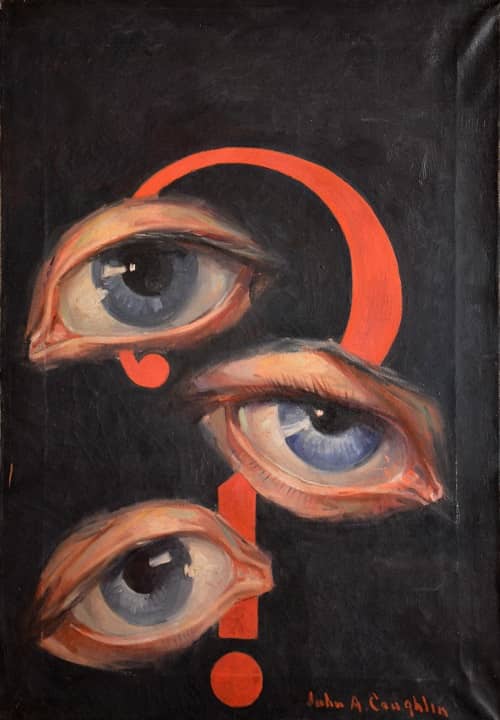The Shadow Knows A Good Pulp Painting When He Sees It!
Detective Story Magazine, December 2, 1919. Art by John Coughlin
I thought that today I’d tell the tale of a painting by the talented and prolific John Coughlin, which was used as a pulp cover not once but twice.
Its first appearance was over a century ago, as it graced the cover of the December 2, 1919 issue of Street & Smith’s Detective Story Magazine. At that time, it illustrated “Eyes of Blue” by Arthur P. Hankins. But its more famous appearance came a dozen years later.
Street & Smith created the character of The Shadow to narrate “The Detective Story Magazine Hour” on radio. That weekly program was launched on July 31, 1930 to promote Detective Story Magazine, and dramatized a story from the current issue. The character of The Shadow was a huge hit, and listeners began asking their news dealers for copies of that Shadow magazine. Sadly for Street & Smith and their prospective customers, there was no such magazine.
Not surprisingly, they soon decided to rectify this and publish a Shadow pulp to cash in on this interest, but uncertain of its prospects, they made it a quarterly. They also didn’t want to incur the expense of buying new cover art for the first issue, dated April 1931. So they decided to recycle a painting in their inventory that featured a Chinese man – Modest Stein’s cover for the October 1, 1919 issue of Street & Smith’s The Thrill Book. Author Walter Gibson was then told to set part of the first Shadow story (“The Living Shadow”) in Chinatown, and they used Stein’s old cover, adding a shadow to the cover in production.
Similarly, for the second issue of The Shadow, dated July 1931, they still weren’t willing to shell out for new cover art. Ransacking their files once more, they found the cover for the December 2, 1919 issue of Detective Story Magazine. It had eyes on it, which fit with the title of the second Shadow novel – “The Eyes of The Shadow.” Once again, they added the figure of The Shadow to the cover in production.
The Shadow, July 1931. Art still by John Coughlin
The acquisition of this painting was a bit nerve-wracking.
In the fall of 2015, out of the blue I received an email from an antique dealer in California. He sent me two very blurry photos of a painting, which I immediately recognized as the cover to the July 1931 issue of The Shadow (sans shadow figure). He told me to get back to him if I was interested. He referred to the painting as “Feminine Eyes of Blue,” which he said was written on the back of the canvas (along with the date Dec 2 1919).
Needless to say, I was very interested! I wrote back immediately, asking how much he wanted for it, asking him to send better photographs and giving him my cell number. After a few anxious hours, he gave me a call. He told me that he’d picked up the painting at an antique store in Pennsylvania, on a recent cross-country road trip, for $200. Now that he was back home on the West Coast, he’d decided to sell it. He’d offered the painting to one guy already, a fellow antiques dealer he knew who was local to him, but that guy had passed on it. Looking online he’d found my name, so had decided to send the images to me.
I thanked him, and told him I was very interested, but would like to see better photos and wanted to know how much he was asking for it. He told me he was still thinking about price, and would send the photos and price when he got home, which would be late that night.
When I got up the next morning, I immediately checked my email, and found several nice photos of the painting. The price was also good; though much more than he’d paid for it, it was less than I’d have been willing to spend. I emailed him back right away, telling him I’d take it. Needless to say, I was very excited when I went to work that day!
However, a call from him a few hours later was like a sucker punch to the gut. After he’d sent me the images, the first guy he’d contacted about the painting called him back, having changed his mind about buying it. So, very sorry, but the painting had already been sold.
You could say I was less than pleased. But there wasn’t much I could do about it. I told him that I would be interested in trying to buy the piece from its new owner, and that I’d pay him a finder’s fee if he’d pass my info on and I wound up buying it. He told me he’d do so.
John Coughlin’s original painting
And then I settled down to wait, wondering if I’d ever hear from the new owner. Fortunately for my nerves, the wait was short. The next day caller ID flashed up a number I didn’t recognize, from California. When I answered, the guy on the other end of the line greeted me with, “So, how much are you willing to pay me for that painting for the second issue of The Shadow I just picked up?”
As I’d figured must have happened, although the new owner had originally taken a pass on the painting, he decided to do a little online research and had discovered that it was the cover of the July 1931 issue of The Shadow. And so he’d reversed course and bought it. Though he was an antiques dealer and not an art collector, he told me he liked the piece, and was tempted to keep it and get it restored. I had no clue if that was true or whether he was just saying it to drive up the price, but it didn’t really matter. He had the painting, I didn’t, and if I wanted it, I’d have to meet his price. And as my friend Bob Weinberg often told me, “You never regret the art you buy. You only regret the art you didn’t buy.” Words to live by.
Eventually, after a bit of discussion on the price, we sealed the deal. For owning the piece for a day, he basically doubled his money. And I was out that amount, plus the finder’s fee I owed the original owner, but it didn’t matter.
Lord knows I was thrilled to buy it. And The Shadow knows too!
Doug is a collector of pulps, as well as of pulp, science fiction and fantasy art. He co-founded and co-organizes the Windy City Pulp and Paper Convention. For many years his Tattered Pages Press published the pulp fanzine Pulp Vault, as well as other books on the pulps. He was one of the authors of The Adventure House Guide to Pulps, and has edited several pulp anthologies, including the Best of Adventure series. His book, Uncovered: The Hidden Art Of The Girlie Pulps, an in-depth study of the spicy pulps and their art, was named ForeWord Magazine‘s 2003 Popular Culture Book of the Year. In 2013, Bob Weinberg, Bob Garcia and he collaborated on The Collectors’ Book of Virgil Finlay, a collection of Finlay’s gorgeous art. The Art of the Pulps, which he co-edited with Bob Weinberg and Ed Hulse, won the 2018 Locus Award for Best Art Book.
Doug’s last article for Black Gate was The 1940 Chicon Auction, or, “My Kingdom for a Time Machine!”


